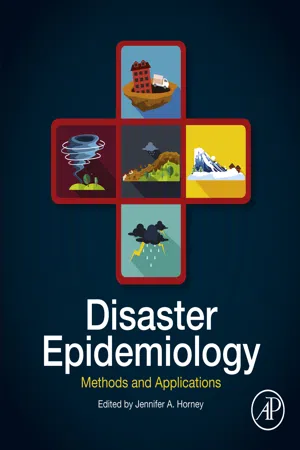
- 212 pages
- English
- ePUB (mobile friendly)
- Available on iOS & Android
About this book
Disaster Epidemiology: Methods and Applications applies the core methods of epidemiological research and practice to the assessment of the short- and long-term health effects of disasters. The persistent movement of people and economic development to regions vulnerable to natural disasters, as well as new vulnerabilities related to environmental, technological, and terrorism incidents, means that in spite of large global efforts to reduce the impacts and costs of disasters, average annual expenditures to fund rebuilding from catastrophic losses is rising faster than either population or the gross world product. Improving the resilience of individuals and communities to these natural and technological disasters, climate change, and other natural and manmade stressors is one of the grand challenges of the 21st century. This book provides a guide to disaster epidemiology methods, supported with applications from practice. It helps researchers, public health practitioners, and governmental policy makers to better quantify the impacts of disaster on the health of individuals and communities to enhance resilience to future disasters.Disaster Epidemiology: Methods and Applications explains how public health surveillance, rapid assessments, and other epidemiologic studies can be conducted in the post-disaster setting to prevent injury, illness, or death; provide accurate and timely information for decisions makers; and improve prevention and mitigation strategies for future disasters. These methods can also be applied to the study of other types of public health emergencies, such as infectious outbreaks, emerging and re-emerging diseases, and refugee health. This book gives both the public health practitioner and researcher the tools they need to conduct epidemiological studies in a disaster setting and can be used as a reference or as part of a course.- Provides a holistic perspective to epidemiology with an integration of academic and practical approaches- Showcases the use of hands-on techniques and principles to solve real-world problems- Includes contributions from both established and emerging scholars in the field of disaster epidemiology
Frequently asked questions
- Essential is ideal for learners and professionals who enjoy exploring a wide range of subjects. Access the Essential Library with 800,000+ trusted titles and best-sellers across business, personal growth, and the humanities. Includes unlimited reading time and Standard Read Aloud voice.
- Complete: Perfect for advanced learners and researchers needing full, unrestricted access. Unlock 1.4M+ books across hundreds of subjects, including academic and specialized titles. The Complete Plan also includes advanced features like Premium Read Aloud and Research Assistant.
Please note we cannot support devices running on iOS 13 and Android 7 or earlier. Learn more about using the app.
Information
History of Disaster Epidemiology
1960–2015
Abstract
Keywords
Background
1960s–1980s
Rapid Needs Assessments
Table of contents
- Cover image
- Title page
- Table of Contents
- Copyright
- Dedication
- List of Contributors
- Acknowledgments
- Introduction to Disaster Epidemiology
- Chapter 1. History of Disaster Epidemiology: 1960–2015
- Chapter 2. Methods: Surveillance
- Vignette: Veterans Health Affairs, Veterans, and Disasters
- Chapter 3. Applications: Using Information Systems to Improve Surveillance During Disasters
- Chapter 4. Applications: Shelter Surveillance
- Vignette: Postdisaster Carbon Monoxide Surveillance
- Chapter 5. Applications: Disaster-Related Mortality Surveillance: Challenges and Considerations for Local and State Health Departments
- Chapter 6. Methods: Study Designs in Disaster Epidemiology
- Chapter 7. Applications: Community Assessment for Public Health Emergency Response
- Chapter 8. Applications: Assessment of Chemical Exposures: Epidemiologic Investigations After Large-Scale Chemical Releases
- Vignette: Geothermal Venting and Emergency Preparedness—Lake County, California
- Vignette: CASPER in Response to a Slow-Moving Disaster—The California Drought
- Chapter 9. Methods: Questionnaire Development and Interviewing Techniques
- Vignette: Investigating Foodborne Outbreaks
- Chapter 10. Applications: Social Vulnerability to Disaster (Hampton and Hertford Counties—Isabel)
- Chapter 11. Applications: Emergency Responder Health Monitoring and Surveillance: Successful Application
- Vignette: Experiences Working With Ebola Virus Disease and Pregnancy in Sierra Leone, 2014
- Chapter 12. Methods: Data Analysis for Disaster Epidemiology
- Chapter 13. Applications: Biosurveillance, Biodefense, and Biotechnology
- Vignette: Climate Change Effects on Flooding During Hurricane Sandy (2012)
- Vignette: Disasters and Chronic Medical Conditions
- Chapter 14. Applications: Disaster Communication and Community Engagement
- Vignette From Recent Responses: Roseburg, Oregon Mass Shooting
- Chapter 15. What Can Disaster Epidemiology Contribute to Building Resilient Communities?
- Appendix: Disaster Resources
- Index